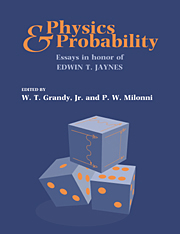Book contents
- Frontmatter
- Contents
- Preface
- Recollections of an Independent Thinker
- A Look Back: Early Applications of Maximum Entropy Estimation to Quantum Statistical Mechanics
- The Jaynes–Cummings Revival
- The Jaynes–Cummings Model and the One-Atom-Maser
- The Jaynes–Cummings Model is Alive and Well
- Self-Consistent Radiation Reaction in Quantum Optics – Jaynes' Influence and a New Example in Cavity QED
- Enhancing the Index of Refraction in a Nonabsorbing Medium: Phaseonium Versus a Mixture of Two-Level Atoms
- Ed Jaynes' Steak Dinner Problem II
- Source Theory of Vacuum Field Effects
- The Natural Line Shape
- An Operational Approach to Schrödinger's Cat
- The Classical Limit of an Atom
- Mutual Radiation Reaction in Spontaneous Emission
- A Model of Neutron Star Dynamics
- The Kinematic Origin of Complex Wave Functions
- On Radar Target Identification
- On the Difference in Means
- Bayesian Analysis, Model Selection and Prediction
- Bayesian Numerical Analysis
- Quantum Statistical Inference
- Application of the Maximum Entropy Principle to Nonlinear Systems Far from Equilibrium
- Nonequilibrium Statistical Mechanics
- A Backward Look to the Future
- Appendix: Vita and Bibliography of Edwin T. Jaynes
- Index
The Kinematic Origin of Complex Wave Functions
Published online by Cambridge University Press: 21 October 2009
- Frontmatter
- Contents
- Preface
- Recollections of an Independent Thinker
- A Look Back: Early Applications of Maximum Entropy Estimation to Quantum Statistical Mechanics
- The Jaynes–Cummings Revival
- The Jaynes–Cummings Model and the One-Atom-Maser
- The Jaynes–Cummings Model is Alive and Well
- Self-Consistent Radiation Reaction in Quantum Optics – Jaynes' Influence and a New Example in Cavity QED
- Enhancing the Index of Refraction in a Nonabsorbing Medium: Phaseonium Versus a Mixture of Two-Level Atoms
- Ed Jaynes' Steak Dinner Problem II
- Source Theory of Vacuum Field Effects
- The Natural Line Shape
- An Operational Approach to Schrödinger's Cat
- The Classical Limit of an Atom
- Mutual Radiation Reaction in Spontaneous Emission
- A Model of Neutron Star Dynamics
- The Kinematic Origin of Complex Wave Functions
- On Radar Target Identification
- On the Difference in Means
- Bayesian Analysis, Model Selection and Prediction
- Bayesian Numerical Analysis
- Quantum Statistical Inference
- Application of the Maximum Entropy Principle to Nonlinear Systems Far from Equilibrium
- Nonequilibrium Statistical Mechanics
- A Backward Look to the Future
- Appendix: Vita and Bibliography of Edwin T. Jaynes
- Index
Summary
ABSTRACT. A reformulation of the Dirac theory reveals that iћ has a geometric meaning relating it to electron spin. This provides the basis for a coherent physical interpretation of the Dirac and Schödinger theories wherein the complex phase factor exp(–iφ / ћ) in the wave function describes electron zitterbewegung, a localized, circular motion generating the electron spin and magnetic moment. Zitterbewegung interactions also generate resonances which may explain quantization, diffraction, and the Pauli principle.
You know, it would be sufficient to really understand the electron.
—Albert EinsteinIntroduction
Edwin T. Jaynes is one of the great thinkers of twentieth century science. More than anyone else he has deepened and clarified the role of statistical inference in science and engineering. To my mind, his greatest accomplishment has been to recognize that in the evolution of statistical mechanics the principles of physics had gotten confused with principles of statistical inference, and then to show how the two can be cleanly separated to produce a simpler yet more powerful theoretical system.
I share with Ed Jaynes the belief that quantum mechanics suffers from an analogous muddle of probability with physics, which is at the root of the perennial controversy over physical interpretation.
Though a Jaynesian revolution of the “quantum muddle” remains elusive, I will report here on a promising possibility that has been overlooked.
- Type
- Chapter
- Information
- Physics and ProbabilityEssays in Honor of Edwin T. Jaynes, pp. 153 - 160Publisher: Cambridge University PressPrint publication year: 1993
- 1
- Cited by



